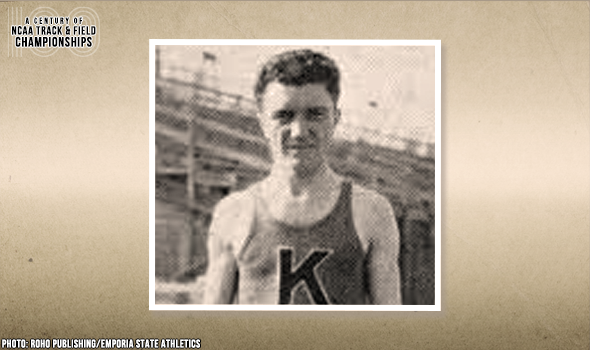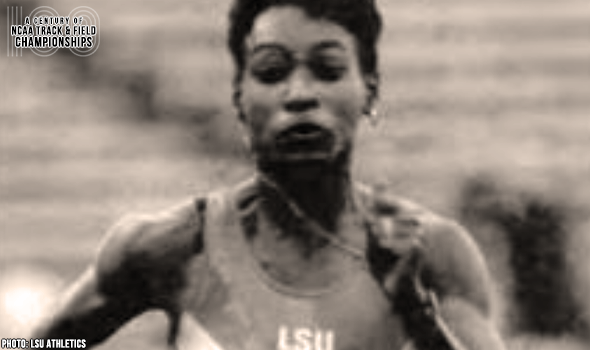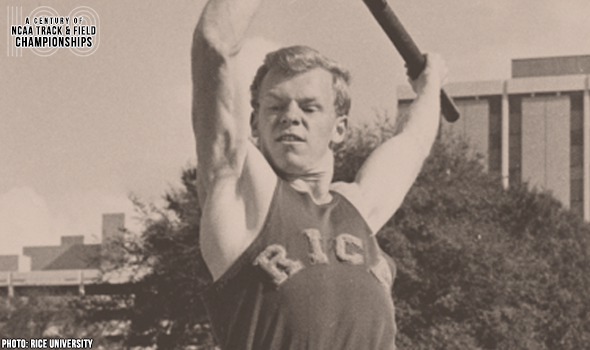
Hurdling History For Forrest “Spec” Towns
Forrest Towns didn’t seem like a record-breaking hurdler when he entered Georgia.
He fell down in his first attempt at the event.
But, two years later, the man known as “Spec” for his freckled face won every hurdles race in sight, including the 1936 NCAA Championships and Berlin Olympics 110-meter hurdles.
His whirlwind year in 1936 saw him run faster than the world record of 14.2 an amazing 10 times. Nine of those were in 14.1, but the fastest came in a post-Olympic race in which he lowered the WR to 13.7 – an improvement by four tenths of a second that remains the largest improvement in event history.
The race was in Oslo, Norway, and Per Avatsmark described the race in Sportsmanden: “From stride one his speed was so great that he virtually flew over the first hurdle. The rest of the race was as perfect as the beginning.”
Towns recalled, “I got off to an unusually good start that day. When I broke the tape I turned around and looked back. The nearest guy was just then clearing the last hurdle. One of the hurdlers came over and banged me on the back and told me I had run a new world record. I asked him, ‘What did I do – run it in 14-flat?’ He said, ‘No, you ran 13.7.’ All I said was, ‘Aw, hell.’”
Towns was well into a winning streak that reached 60 races and lasted through a repeat win at the 1937 NCAA Championships, becoming the event’s first two-time winner.
A month before the NCAA meet Towns was the Bulldogs’ leading scorer at the SEC Outdoor Championships as Georgia won the team title for the first time (It remains the program’s only men’s team title, including indoors). Towns won the 120-yard and 220-yard hurdles and added thirds in the 100 yards and high jump.
Coincidentally, it was high jumping of sorts that got Towns an athletic scholarship. Augusta Chronicle sportswriter Tom Wall witnessed his neighbor’s high school boy jumping over a fishing pole that was placed on the top of the heads of his dad and uncle. It was Towns, and Wall wrote a story about the raw talent that found its way to Weems Baskin, then an assistant coach at Georgia.
Baskin – the 1927 NCAA 120H champ for Auburn – had him try the hurdles. Towns’ wife, Martha, related in a UGA DogBytes story in 2004: “The first time he ran the hurdles on a cinder track he fell and had cinders from his shoulders to his ankles. He got up and asked coach Baskin if he could try it again and coach Baskin said at that moment I knew I had a hurdler.”
Baskin eventually was head coach at Georgia for a year before leaving for longer stints at Ole Miss and South Carolina. His replacement at Georgia in 1939 was Towns, who continued through 1974 – a 36-year period believed to be the longest in SEC track & field history. Towns and Baskin were inducted as part of the 2001 class to the USTFCCCA Coaches Hall of Fame.
Georgia began the Spec Towns Invitational in 1977 and named its outdoor facility Forrest Towns Track in 1990.
The NCAA and collegiate track & field will mark a momentous milestone in the spring of 2021 -- the 100th anniversary of the NCAA Championships and with that, the NCAA Track & Field Championships. In June 1921, the University of Chicago hosted the first track & field championships in NCAA history.
This point can’t be emphasized enough: Not only was the event the first for NCAA track & field, but the first championships for any sport under the sponsorship of the NCAA.
To celebrate, over each of the next 365 days, the U.S. Track & Field and Cross Country Coaches Association (USTFCCCA) will celebrate moments, student-athletes, and coaches that have made a century’s worth of championships special. From humble beginnings to important historical milestones to the modern-day, collegiate track & field has evolved with the American society.
The 2021 edition of the NCAA Division I Outdoor Track & Field Championships begin with preliminary round action on May 27-29 in Jacksonville, Fla., and College Station, Texas. The championships final site and culmination of the celebration is slated for June 9-12, 2021 at the newly rebuilt Hayward Field in Eugene, Ore.

Clemson’s Ross Kept Getting Faster In 1995
Duane Ross PR’d twice in the 110H at the 1995 NCAA DI Outdoor T&F Championships. When Ross won in 13.32, he became the No. 3 performer in collegiate history.

Illinois’ Kerr Went Back-To-Back At NCAAs
George Kerr won back-to-back 800/880 titles at the NCAA Outdoor T&F Championships in 1959 & 1960. Kerr set a meet record of 1:46.4 in the 800 meters in 1960.

UCLA’s Baucham Bounded To TJ CR In 2005
Candice Baucham won the triple jump at the 2005 NCAA DI Outdoor T&F Championships with a collegiate record of 14.07m (46-2). Baucham took the event by more than one foot.

San Romani Went From Unknown To Legend
Archie San Romani won back-to-back 1500/mile crowns at the NCAA Outdoor T&F Championships in 1935 & 1936.

Auburn’s Glance Made Them Look Twice
Harvey Glance completed the 100-200 double as a freshman at the 1976 NCAA DI Outdoor T&F Championships. He set a meet record of 10.16 in the 100.

Nova’s Rhines Did NCAA 5K Three-Peat
Jen Rhines was the first female athlete in the history of the NCAA DI Outdoor T&F Championships to win three consecutive 5K titles.

Georgia’s Erm Cruised To 2019 Decathlon Title
Johannes Erm won the decathlon at the 2019 NCAA DI Outdoor T&F Championships by 342 points with his 8352 total. That was also the fifth-best score in meet history.

McMillen Adapted, Set 1500 MR In 1952
Bob McMillen set a meet record in the 1500 meters of 3:50.7 at the 1952 NCAA Outdoor Track & Field Championships.

LSU’s Duhaney Destroyed NCAA 200 Field In 1992
Dahlia Duhaney owns the largest margin of victory in meet history in the 200 with her 0.44-second winner at the 1992 NCAA DI Outdoor T&F Championships.

Rice’s Roberts Cooked Up Pole Vault Greatness
Dave Roberts was the second man to win three consecutive pole vault titles at the NCAA DI Outdoor T&F Championships, doing so from 1971 to 1973.

